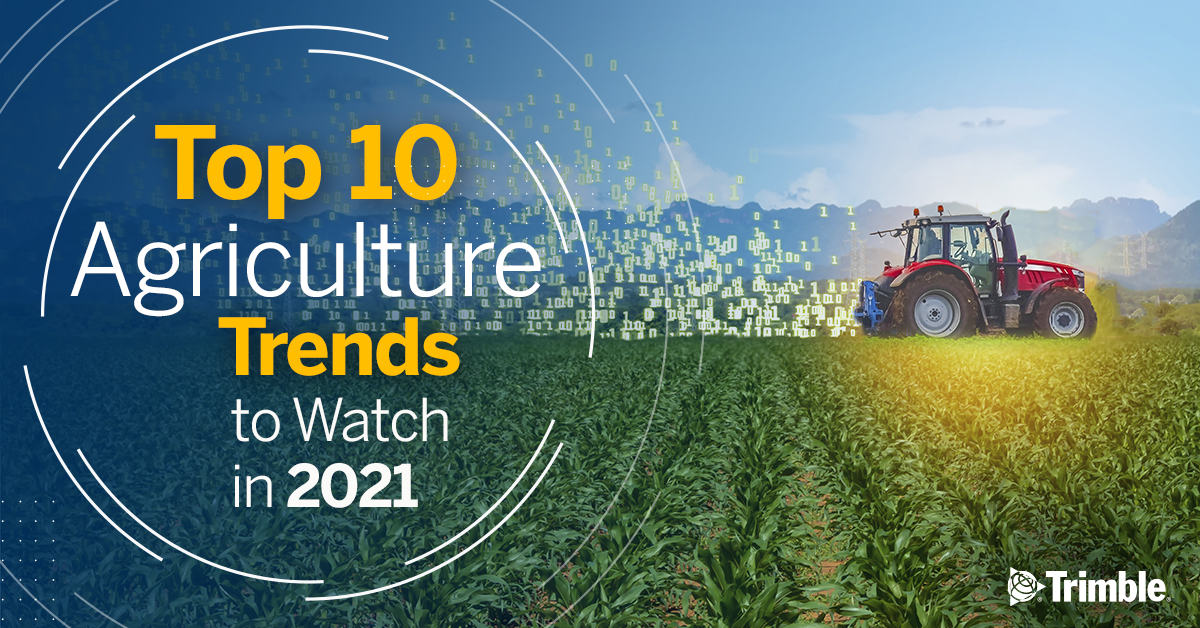Top 10 Agriculture Trends to Watch in 2021
January 8, 2021

The Top 10 Ag Trends to Look Out for in 2021
As we say goodbye to 2020, it’s time to take a look at the top 10 agriculture trends to look out for in 2021. While individual trends are diverse, most point to two main themes: new technology and solutions for a changing climate. Watch for the following in 2021 as farmers strive to increase profits while preserving their land.
1. Increased Use of Aerial Imaging
More farmers will turn to aerial imaging to better manage their crops in 2021. Satellite imaging and drone technology allow farmers to see crop variations and issues that are hard to spot from the ground. When this data is coupled with precision ag technology, farmers will be able to manage their crops more accurately, allowing for increased profits.
2. A Focus on Water Management
According to NOAA, costly extreme weather events such as heavy rainfalls and droughts, are increasing. In the United States alone, there were 16 weather events that resulted in at least $1 billion in damages. These events not only damage homes, but also farmland and crops. To help mitigate the risks of these events, farmers will utilize water management tools and technology to better handle these extreme events.
3. Regenerative Agriculture
Due to concerns about climate change and weather volatility, more consumers are pushing organizations and individuals to adopt regenerative agriculture practices. This broad term refers to practices that increase soil carbon sequestration, such as reduced tillage and the use of cover crops. While professionals debate whether regenerative agriculture will be a solution for climate change mitigation, scientists agree these practices increase soil health and fertility.
4. Precise Nitrogen Applications
Increasing concerns about agriculture’s role in the release of the greenhouse gas nitrous oxide will lead to more precise applications of nitrogen fertilizers. Technologies such as the GreenSeeker® crop sensing system and the Field-IQ™ input control system will help growers meet plant nitrogen needs without overapplying fertilizer, which leads to decreased costs and increased profits. One study showed that using the GreenSeeker® with barley reduced N applications by 50% while maintaining yield.
5. Digital Information Sharing
In many cases, COVID-19 made it essential for farmers and industry members to transition from in-person chats to digital meetings. Even after the pandemic diminishes, it’s likely that much of this communication will remain digital. When farmers can share data, sign paperwork, and receive advice digitally, it saves them time and money. This allows for increased communication with equipment providers, crop advisors, and other professionals.
6. Localized Weather Data
Gone are the days when checking the weather meant looking at a zip code’s forecast. In-field sensors allow for instantaneous and accurate readings of wind, rainfall, and temperature. When combined with data management software, this accurate weather data will help inform spraying, irrigating, and harvest windows.
7. Accurate Yield Predictions
New technologies will allow farmers to quickly and accurately predict yields before crops are harvested. With accurate yields, farmers will be able to find buyers for all of their harvest, eliminating food waste and increasing profits. Furthermore, yield monitoring technology will help inform the following year’s variety selection and yield.
8. Investments in Indoor Farming
Startup companies continue to receive support for the indoor production of produce such as lettuce and tomatoes. Hundreds of vertical farming startups aim to utilize sensors and protective culture to produce vegetables in small spaces close to urban areas. Investors will also continue backing rural operations such as AppHarvest in Kentucky, USA.
9. Field Mapping
According to BusinessWire, the global digital agriculture market is expected to record a CAGR of 9.9% between 2020-2021, and field mapping will see the largest growth. It’s no surprise, since field mapping allows for more accurate planting, spraying, and harvesting.
10. Data Integration
Even if you have information about yields, input costs, soil type, and weather conditions, integrating this data is key to putting it to use. Data management software will allow farmers to leverage this data to inform their decision making. Plus, this data can be used in real-time to make adjustments such as altering planting depth based on available moisture.
Stay on Top of Trends
Since many of these top 10 trends point to an increase in the adoption of precision agriculture technology, connect with your local reseller to learn more about integrating these technologies into your farm.
Tags: data connectivity, data management, farm management, farm trends, farming, Field maps, Precision Ag, precision agriculture, Regenerative ag, Yield monitoring, yield monitors